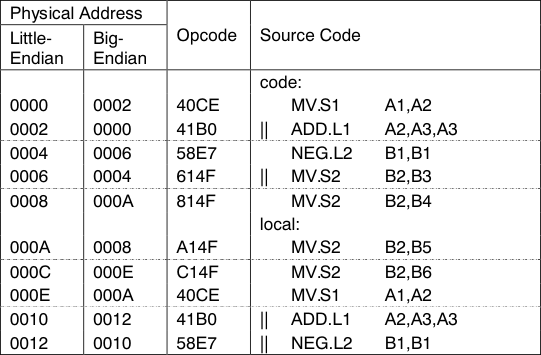SPRAB89A September 2011 – March 2014
- 1 Introduction
- 2 Data Representation
- 3 Calling Conventions
- 4 Data Allocation and Addressing
- 5 Code Allocation and Addressing
- 6 Addressing Model for Dynamic Linking
-
7 Thread-Local Storage Allocation and Addressing
- 7.1 About Multi-Threading and Thread-Local Storage
- 7.2 Terms and Concepts
- 7.3 User Interface
- 7.4 ELF Object File Representation
- 7.5
TLS Access Models
- 7.5.1 C6x Linux TLS Models
- 7.5.2 Static Executable TLS Model
- 7.5.3 Bare-Metal Dynamic Linking TLS Model
- 7.6 Thread-Local Symbol Resolution and Weak References
- 8 Helper Function API
-
9 Standard C Library API
- 9.1 Reserved Symbols
- 9.2 <assert.h> Implementation
- 9.3 <complex.h> Implementation
- 9.4 <ctype.h> Implementation
- 9.5 <errno.h> Implementation
- 9.6 <float.h> Implementation
- 9.7 <inttypes.h> Implementation
- 9.8 <iso646.h> Implementation
- 9.9 <limits.h> Implementation
- 9.10 <locale.h> Implementation
- 9.11 <math.h> Implementation
- 9.12 <setjmp.h> Implementation
- 9.13 <signal.h> Implementation
- 9.14 <stdarg.h> Implementation
- 9.15 <stdbool.h> Implementation
- 9.16 <stddef.h> Implementation
- 9.17 <stdint.h> Implementation
- 9.18 <stdio.h> Implementation
- 9.19 <stdlib.h> Implementation
- 9.20 <string.h> Implementation
- 9.21 <tgmath.h> Implementation
- 9.22 <time.h> Implementation
- 9.23 <wchar.h> Implementation
- 9.24 <wctype.h> Implementation
-
10C++ ABI
- 10.1 Limits (GC++ABI 1.2)
- 10.2 Export Template (GC++ABI 1.4.2)
- 10.3 Data Layout (GC++ABI Chapter 2)
- 10.4 Initialization Guard Variables (GC++ABI 2.8)
- 10.5 Constructor Return Value (GC++ABI 3.1.5)
- 10.6 One-Time Construction API (GC++ABI 3.3.2)
- 10.7 Controlling Object Construction Order (GC++ ABI 3.3.4)
- 10.8 Demangler API (GC++ABI 3.4)
- 10.9 Static Data (GC++ ABI 5.2.2)
- 10.10 Virtual Tables and the Key function (GC++ABI 5.2.3)
- 10.11 Unwind Table Location (GC++ABI 5.3)
-
11Exception Handling
- 11.1 Overview
- 11.2 PREL31 Encoding
- 11.3 The Exception Index Table (EXIDX)
- 11.4 The Exception Handling Instruction Table (EXTAB)
- 11.5 Unwinding Instructions
- 11.6 Descriptors
- 11.7 Special Sections
- 11.8 Interaction With Non-C++ Code
- 11.9 Interaction With System Features
- 11.10 Assembly Language Operators in the TI Toolchain
- 12DWARF
- 13ELF Object Files (Processor Supplement)
- 14ELF Program Loading and Dynamic Linking (Processor Supplement)
-
15Linux ABI
- 15.1 File Types
- 15.2 ELF Identification
- 15.3 Program Headers and Segments
- 15.4 Data Addressing
- 15.5 Code Addressing
- 15.6 Lazy Binding
- 15.7 Visibility
- 15.8 Preemption
- 15.9 Import-as-Own Preemption
- 15.10 Program Loading
- 15.11 Dynamic Information
- 15.12 Initialization and Termination Functions
- 15.13 Summary of the Linux Model
- 16Symbol Versioning
- 17Build Attributes
- 18Copy Tables and Variable Initialization
- 19Extended Program Header Attributes
- 20Revision History
5.4 Addressing Compact Instructions
The C64+ ISA and some later variants have a feature known as compact instructions, an encoding format that packs pairs of 16-bit instructions into 32-bit words of program memory. In big-endian mode, the instructions are stored in memory in the opposite order from their lexical order in the source program, and opposite from the order in which they execute. This section clarifies the conventions for representing addresses in the face of this discrepancy.
A 16-bit instruction may be considered to have two addresses:
- Its physical address is the address in which it physically resides in program memory.
- Its logical address is the address at which it appears to reside from the point of view of the program's control flow. The logical address can be thought of as the program counter value corresponding to the instruction. The program executes instructions in logical address order, corresponding to the lexical order of the program. Branch targets and displacements are computed according to logical addresses.
In the little-endian configuration, logical addresses are the same as physical addresses. In big-endian, pairs of 16-bit instructions are swapped in program memory such that if address A represents the physical address of the 32-bit word containing the pair, the first logical instruction is stored A+2 and the second at A.
The code fragment in Figure 5-1 illustrates the distinction between logical and physical addresses. The program is shown in its lexical order. The first column shows the little-endian physical address, which is also the logical address for both little- and big-endian. The second column shows the big-endian physical address. The dashed lines represent 32-bit boundaries in program memory.
 Figure 5-1 Addressing Compact Instructions
Figure 5-1 Addressing Compact InstructionsThe ABI specifies that all program addresses in the object file are represented as logical addresses. This includes branch displacements, symbol values, addresses in unwinding tables, and addresses in debug information.
Referring to Figure 5-1, the value of the label code in the symbol table is 0x0000 even though the instruction it labels (opcode 0x40CE) is stored at 0x0002. Similarly, the value of the label local is 0x000A even though the instruction it labels (opcode 0xA14F) is stored at 0x0008.
For the most part the distinction between logical and physical addresses is transparent to both the programmer and the toolchain. To preserve this transparency, the following conditions are imposed:
- Branches must be to labeled instructions. It is possible to construct a branch to an unlabeled instruction but the results are undefined.
- With certain exceptions, labels must be aligned on 32-bit boundaries. The exceptions are:
- A label that can be determined not to be a branch destination (e.g. a DWARF label)
- A label that is the target of an intra-section branch from one fetch packet to another (the compact form of BNOP encodes a half-word offset).
- A relocatable field cannot occur within a 16-bit instruction.
Conditions (1) and (2) taken together exclude indirect branches to addresses that are not 32-bit aligned. Note an instance of (2b) does not require a relocation since the offset is an assembly-time constant. This in turn enables condition (3), sidestepping the need to translate between logical and physical addresses to access a relocatable field.